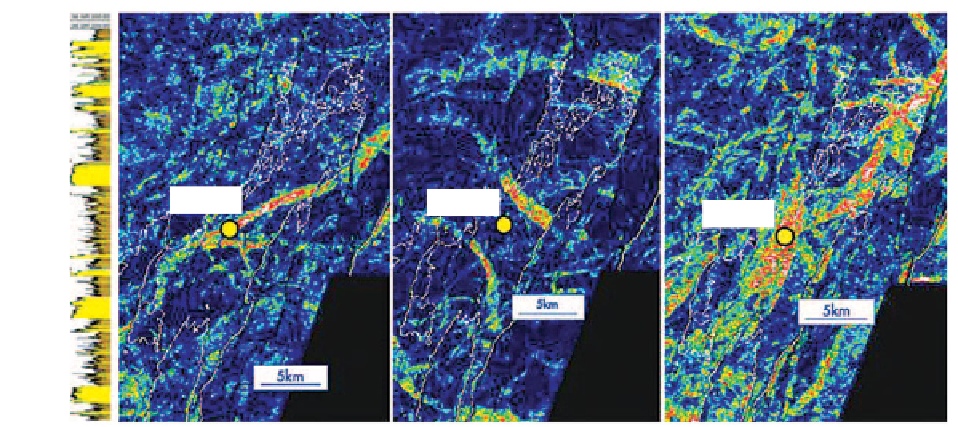Geology Reference
In-Depth Information
C2
well-x
well-x
well-x
D
5km
5km
H
5km
Zone C2: Penetrated predicted
channel (as prognosed)
Zone D: Did not penetrate
channel (as prognosed)
Zone H: Penetrated predicted
channel (as prognosed)
Figure 10.40
Seismic amplitude predicting reservoir and fluid properties, from Kloosterman and Pichon (
2012
).
As a consequence hydrocarbon in place assessments
based on DHI observations tend to have narrower
ranges than those based on geological considerations
of trap integrity and spill points. Roden et al.(
2012
)
suggest using a DHI index to weight the volumetric
outputs from the two approaches.
defined as a grouping of one or more technologies
that have been field tested and have been demon-
strated to provide reasonably certain results with
consistency and repeatability in the formation being
evaluated or in an analogous formation. These dis-
closure rules are closely aligned to the Petroleum
Resources Management System (PRMS) that has
been published under the sponsorship of the Society
of Petroleum Engineers (SPE) and others (Lorenzen
et al.,
2012
).
Given the developments in seismic fidelity and
amplitude interpretation over the past ten years or
so it is clear that seismic amplitude technologies
may have more of a role to play in establishing proven
reserves. Some examples of the use of seismic in
practice have been given by Kloosterman and Pichon
(
2012
). For example, a common problem is the need
to assess an accumulation that consists of several fault
blocks, only some of which have been drilled. Then
the PRMS guidelines (which should be consulted for
additional detail) indicate that seismic amplitude
anomalies may be used to support reservoir and fluid
continuity across the faults provided that:
10.6 Seismic amplitude technology in
reserves estimation
The reporting of hydrocarbon reserves, for the pur-
pose of assigning value to companies or projects,
follows strict guidelines laid out by stock market
regulators, primarily the Securities and Exchange
Commission (SEC) of the United States. The SEC
rules specify, for example, that the area of reservoir
considered as proved includes undrilled portions of
the reservoir that can with
be
judged to be continuous with the area identified by
drilling and to contain economically producible oil or
gas on the basis of available geoscience and engineer-
ing data. Also, in the absence of data on fluid con-
tacts, proved reserves are limited by the lowest
known hydrocarbons as seen in a well penetration,
unless geoscience, engineering or performance data
and reliable technology establishes a lower contact
with reasonable certainty. Reliable technology is
'
reasonable certainty
'
within the drilled fault block, well data
demonstrate a strong tie between the
hydrocarbon-bearing reservoir and the seismic
anomaly,
252













